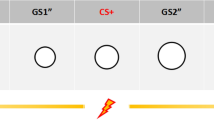Abstract
In an experiment designed to demonstrate evaluative conditioning, subjects were shown 48 pictures of sculptures that they rated on a scale with 21 categories (−10 to +10). Then, the two most liked pictures (L) were paired with pictures from the categories −1, 0, or +1 (N). In contrast to prior experiments, subjects were given either forward conditioning (N-L) or backward conditioning (L-N) trials but not both. Four other neutral stimuli were paired with each other (N-N) and acted as control stimulus pairs. After conditioning, the stimuli were rated a second time. There was a statistically significant difference in evaluative ratings showing a change of the evaluative tone of the previously neutral stimuli in a positive direction only after forward conditioning. This finding is inconsistent with results of prior experiments and challenges the assumption of Martin and Levey (1987) that evaluative conditioning is different from human classical conditioning.
Similar content being viewed by others
References
Baeyens, F., Eelen, P., & Van den Bergh, O. (1990). Contingency awareness in evaluative conditioning: A case for unaware affective-evaluative learning.Cognition and Emotion, 4, 3–18.
Dawson, M.E., & Schell, A.M. (1987). Human autonomic and skeletal classical conditioning: The role of conscious cognitive factors. In G. Davey (Ed.),Cognitive processes and Pavlovian conditioning in humans (pp. 27–55). Chichester, England: Wiley.
Furedy, J.J. (1991). Some recalcitrant views on the role of noncognitive S-R factors in human Pavlovian autonomic conditioning: Some facts still haunt us.Integrative Physiological and Behavioral Science, 26, 21–25.
Levey, A.B., & Martin, I. (1975). Classical conditioning of human ‘evaluative’ responses.Behaviour Research and Therapy, 13, 221–226.
Martin, I., & Levey, A.B. (1987). Learning what will happen next: Conditioning, evaluation, and cognitive processes. In G. Davey (Ed.),Cognitive processes and Pavlovian conditioning in humans (pp. 57–81). Chichester, England: Wiley.
Miller, N.E. (1951). Learnable drives and rewards. In S.S. Stevens (Ed.),Handbook of experimental psychology (pp. 435–472). New York: Wiley.
Shanks, D.R., & Dickinson, A. (1990). Contingency awareness in evaluative conditioning: A comment on Baeyens, Eelen, and van den Bergh.Cognition and Emotion, 4, 19–30.
Staats, C.K., & Staats, A.W. (1957). Meaning established by classical conditioning.Journal of Experimental Psychology, 54, 74–80.
Author information
Authors and Affiliations
Corresponding author
Rights and permissions
About this article
Cite this article
Hammerl, M., Grabitz, HJ. Human evaluative conditioning: Order of stimulus presentation. Integrative Physiological and Behavioral Science 28, 191–194 (1993). https://doi.org/10.1007/BF02691227
Issue Date:
DOI: https://doi.org/10.1007/BF02691227




